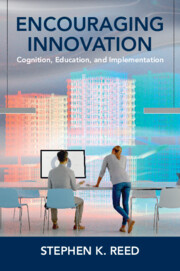Book contents
- Encouraging Innovation
- Encouraging Innovation
- Copyright page
- Dedication
- Contents
- Preface
- Part I Cognition
- Chapter 1 Reasoning
- Chapter 2 Problem Solving
- Chapter 3 Creativity
- Chapter 4 Group Decision Making
- Chapter 5 Collaborative Problem Solving
- Part II Education
- Part III Implementation
- References
- Name Index
- Subject Index
Chapter 3 - Creativity
from Part I - Cognition
Published online by Cambridge University Press: 17 August 2023
- Encouraging Innovation
- Encouraging Innovation
- Copyright page
- Dedication
- Contents
- Preface
- Part I Cognition
- Chapter 1 Reasoning
- Chapter 2 Problem Solving
- Chapter 3 Creativity
- Chapter 4 Group Decision Making
- Chapter 5 Collaborative Problem Solving
- Part II Education
- Part III Implementation
- References
- Name Index
- Subject Index
Summary
Expertise implies that people are usually good problem solvers in their area of expertise but expertise doesn’t necessarily imply that they are creative. Creativity requires that the solutions are not only correct but also novel and useful. New solutions, such as using dental floss to hang objects on a wall, are needed in daily life when typical solutions are not readily available. One approach to studying creativity is to observe creative people such as artists, sculptors, jazz musicians, and actors. Another approach is to conduct controlled experiments such as evaluating the effectiveness of examples in producing creative products. The Geneplore model of thinking provides a helpful framework for dividing creative thought into generation and exploration phases. Broad states of mind – exploring the environment rather than exploiting accumulated knowledge – contribute to producing novel solutions. In contrast, anxiety can have a negative impact of creativity. Across many diverse content domains from the arts to the sciences, rated anxiety was greater for activities that required creativity.
- Type
- Chapter
- Information
- Encouraging InnovationCognition, Education, and Implementation, pp. 27 - 40Publisher: Cambridge University PressPrint publication year: 2023

